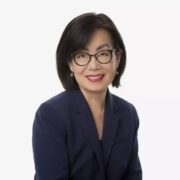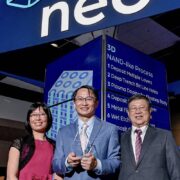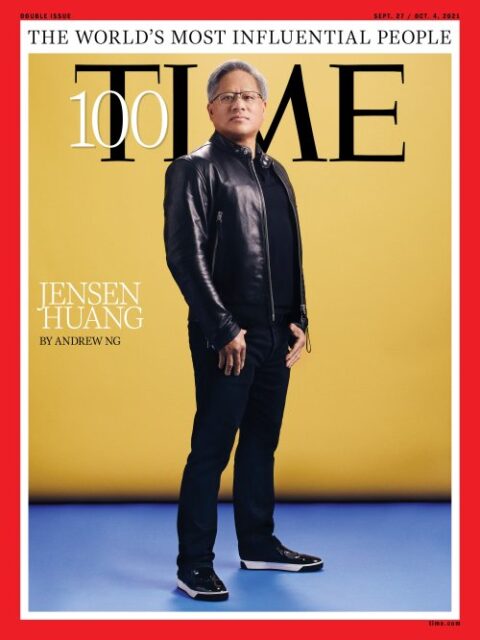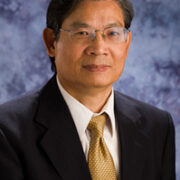許財源: 美國國防部軍事機密中的匿名英雄
Terry Tsaiyuan Hsu: An Anonymous Hero of Military Security in The Defense Department of The USA
作者 廖明惠(許太太)
許財源生於 西元一九五九年八月二十五日,逝於西元一九九八年二月二十六日,享年五十八歲。
財源生於台南。台灣。父親許萬得,母親蔡粉蓮。他從小聰穎多才 ,曾是全台灣華語演講及作文比賽高手。 當年多次遠征台北,高雄參加比賽。他的家中褂滿他的獎旗。除了在文字語文出色外,他更從小極興趣於電器,常自組收音機,電池,馬達及家中電子用品。因從小品學兼優,經常被選為班長,班代表。
他自小家境貧寒,使他養成節簡樸實,克苦勤勞,自力更生的鬥志。在小學時,他就開始投稿國語日報賺零用錢。在高中,他更進一步,翻譯英文文章成中文 ,投稿於多種雜誌。曾是“燈塔”雜誌社的長期翻譯者。大學畢業前,他已翻譯了多本長篇小說。他的大學四年全靠獎學金,家教及翻譯書本,以自資完成學業。
財源畢業於台南一中,以聯考前五名考入台大電機系,是系狀元。 一九六四年以留學生身份來美國打工求學 。一九六六年在田納西大學得電機碩士學位。因有新興起的電腦建築工程。他於一九七零年再入紐約市立大學攻讀電腦設計工程。於 一九七六年得電機電腦設計工程博士,(computer architecture)。之後,獲職於明里蘇達州的電腦公司,Control Data Corporation,迄今已二十一年。他天天忠心上班, 從不請假,也不遲到早退。於一九八四年得 Control Data 的 Technical Excellent Award。
他在Control Data 上班是在美國國防部的最高機密人物的位格上, (Highest National Security Clearance Classification). 所有的人,連家人,包括妻子都不可以知道他上班的工作是做什麽或是為什麽。
許財源的頂尖科技在美國領導下聯軍的Operation Desert Storm, (.一九九一年一月十七日至一九九一年二月二十八日),約在一個月多攻敗伊拉克解救克威特的成績完全顕現出來。
在財源的葬禮上,他的同事說這戰爭在短短的五個多星期就成功,最大的功勞是許財源,他救了千人的性命及美國千萬的財物。這場戰爭是靠許財源設計出的高科技快速打勝的。請看他同事,Steve , 的文章如下:(Steve 在這裡不能明講。)
“We’re not allowed to discuss detail, but you should know Terry worked on state of the art “electrical wonders” with the elite minds of the computer world. The group he worked with forever pushed technology to the limit, a job Terry was perfectly suited for.
“The processing developed by Terry has been the world’s fastest for their specific applications. And you should be proud that his technical expertise helped the U.S. maintain its technological advantage over the rest of the world, ultimately helping maintain peace and stability in the world. Lives were spared because of the work that Terry did. Unfortunately the group he worked with never developed commercial products. So Terry never had much of a chance to receive acclaim.
But seeking acknowledgement or fame was not part of him. Thechallenges and the breaking of new ground in the computer world were enough reward to him.”
財源與明惠結婚於 一九六九年八月二日。育有兩位兒子,益豪及富傑。他對妻兒愛護備至 ,完全負起理家重任,包括家庭帳單 。他沒晚交過帳單,也從不負債。我也從不用操心我的車子,從修護,年年的登記,繳費到保險及換新執照,他全為我處理。家中大大小小電器用品及房子,全靠他負責修䕶。庭院草坪,也全由他一人整理。
因他勤勞克苦,從不讓他的兒子們割草。別人家的兒子,在10-12 歲已開始割草,他的兩個兒子,到16歲仍難得去割草。 他說割草不是一件好受的工作為什麼要讓孩子去做,何況他們長大有家後也得經常割草,所以現在他們還是孩子,就不用割草。同樣的, 他也不讓孩子洗碗,他說孩子以後長大了,也需天天洗碗,現在就不用洗碗。可見他多愛他的孩子。他的小兒子剛滿16歲時,要去外面工作賺零用錢,他叫他不用去外面工作,就給他多些零用錢。他告訴他的兒子,你長大後一生需天天上班,工作好多年不能停止工作。現在你仍是孩子,就不用做工賺錢。工作是很辛苦的,現在多讀書,不用去賺錢。他希望他的孩子多享受無憂無慮的未成年生活。他的孩子也很少在寒冬去除雪。因他認為外面太冷,不應讓孩子去清雪。在許多事上,我看見他愛我們至深。
因財源富創造力,很愛設計東西,他在家中經常有設計工程進行中,經常自製許多小電器用品。例如:自製測速器,用在他打槍時,能測子彈速度。自製電話機的call waiting。自製天秤,自製光力自動開關,自製攝影機及照片放大機,等等。天天忙著不停。他能用各種廢物,如瓶蓋,紙盒,罐子及許多用過的零件, 做出實用的電器用品在家中使用。他喜愛使用自己創製的產品。
因財源常自學東西,不需老師教能學會,所以他常說為什麽需老師教才能學呢?自己可以學很多東西呀! 因此他也常由圖書館借書來學很多。他最近的一大無師自通的成就,就是學會吹豎笛(Clarinet ) 及 薩克斯管 (Saxophone), 已彈得很不錯。他每天練彈超過一小時。他在去年一年中把 Pearl Buck’s 二十多本小說都讀完。
財源不但 勤勉簡樸, 他也奉公守法。 凡事按情順理,講求公義廉正。他以身作則且教導他的孩子們不可犯規觸法,不可做不公正或不清廉的事。在凡事上,他的兒子們都看到他的真為人,不虛不假。我很欣慰他留給他兒子們很好的榜樣 ,成為他們一生的產業。
於去年,一九九七年十一月二十一日,他突然中風,左手左腳不適行。經復健治療,逐漸能走能動手。但自出院後,大約從十二月底開始受中風的後遺症——鬱抑症—— 的侵襲,逐漸變得很鬱抑 ,雖經一個多月的治療,仍無法脫出深度的鬱抑,而致被它克服,喪失了生命。
大約一個多月之前,他自體會到自己的身心軟弱,無力,他求告耶穌,求主進入他心中成為他的救主,除去他的罪。他曾多次與我讀聖經,禱告。我信雖他的身體無法勝過這疾病,他的靈魂已安息於主懷。
許財源
作者 廖明惠(許太太)
財源喜愛用電子器材自己設計,來創作日常實用品。上班八小時的設計工作並沒使他放棄他家庭晚餐後的自得樂趣的電子創作。凡家中需用的電子品,他喜愛用他自己的作品。若是買來的電子產品,他一定要去改造一下或改組一些。這是他的喜好。幾乎所有家中的電子產品,都有過他的開刀手術。他也常自修護他和我的車子。他很驚喜地看着他的嬰兒天天長大,開始走路,開始學走路,說話,他很希望能打開他的腦袋去看他的腦裏如何像電子的運作。
他上班從不缺席,不遲到,不早退。不請假去參加他孩子的學校活動,也不去每年一次的家長與老師的會談。他也不去看醫生。連看牙醫他都是早上七時三十分去的。總是規規矩矩地認真上班,從來不拿病假。他是非常忠於他的上班工作。凡事上,他都是非常可靠,值得信頼的。這就是為什麼他積存了497小時的病假。
他的生活是非常有規律的。二十多年來,每早餐,他一定吃我煮的大豆及Kellogg’s Mini Wheat. 每中餐都在同一家Burger King吃炸魚三明治。每晚餐都與家人在一起。吃飯後一定吃幾粒花生當飯後點心。飯後一小時一定用小盤子吃一個橘子。他穿襯衫,外套夾克,長褲,鞋子都穿很久,破了,才換新的。我就告訴我們的孩子們,他們的父親不會換太太的。他是非常可信靠的。
除了房屋的貸款外,沒有任何人能從他賺利息錢的。他使用信用卡只為了免帶太多的現金。每個月他全部付清他的信用卡帳單,連他用信用卡買車子也是如此的,他從來沒用貸款買車。他教導他的孩子們,要常存款,要有錢付款才可買東西,若沒錢就不買。所以他很謹慎,不浪費錢。
他不要我全時間上班,因他不要我太辛苦。他很喜歡我突然出現與他一起吃午餐。那是我們沒預約的約會。他是我一生可完成信頼的好丈夫。
父親許財源
作者 許益豪(大兒子)
我最早的記憶中有關我與我父親一起做東西的經驗,就是我在一年級時的幼兒童子軍期,我們的童子軍隊有賽車比賽。每一位小童子軍需自做一木製小車,而後用此車去比賽看誰的車跑得最快。這是父子同工的節目,當然是一項父親協助兒子的活動。可是我父親是非常有興趣地把此車當做他的設計工程。他以他的工程師知識,智慧,及大能,全注精力地設計,計算風力,阻力,空氣動力,車速,及阻力系數,等等,(這些都是完全超出我的理解能力範圍的)。他拿出他的工具,他認真地切割及雕刻那塊木頭,又用砂紙細磨切割雕刻後的木塊,又量它的重量,又量裝四個輪子的位置,且裝上所有輪子,又一處處地平衡這一個木車。我所做的只是稍微幫油漆這小車及油漆上車的號碼。比賽那天,“我父親的車子”大顯風光,得了第一名冠軍。
很可惜的是我沒有繼承我父親的精細手藝,也沒有他的工程師創意的頭腦。但在許多其他方面我長成與他很相像。我從沒想到我會相當地像他。因為在我的長大過程中,在許多的事上及信仰上,我的父親與我常強烈的爭執及彼此反對。我後來了解,我就是與他一樣地倔強固執。
我的確被他的典範所雕塑,例如他的工程師職位使他天天早上八點鐘出門上班,下午過五點鐘就回到家。二十多年來,他每天都是八到五的上班,晚間及週末一定與他的家人在一起。我也要成為八到五的上班者,每晚間及週末都與我家庭在一起。這也就是我沒走上醫生,律師,或牧師的工作,因那些是時間相當沒規律的職業。現在我的工作時間也是八到五且是只週一到週五而已,跟我父親的作息表是一樣的。
另一件我跟隨我父親的就是他的喜好學習。他每天晚間一定有看書或閱報紙的時間。他也常去圖書館借書,常是借某位作者的好幾本書。我也跟他一樣如此做。另一件是我父親用錢很謹慎,他總是盡量地省錢及省資源,他早就開始廢物利用。所有的東西及物品,他都用到完全用盡,不能再用為止,他才另買新的。他從不奢侈,也不擺闊。我也跟隨了他的腳步,不買我買不起的東西,也不買不需要的東西,每月一定付清我的信用卡帳目。除了房屋貸款外,我不負債。
我仍有許多學了我父親的例子,太多了。總說一句是:我是我父親的兒子。雖然我現在是一個獨立的人,有自己的生活,但我是依我父親的榜樣雕塑成的。我是值得驕傲的,因我是我父親的兒子,我以此引為榮。
父親許財源
作者 許富傑(小兒子)
我近十二歳的時候,一個夏天,我們全家決定去美國的東部沿海渡假。在八月大太陽下,我愛照相的父親在眾光觀客的當中,照了好多卷我的照片。我還記得我們也去了首都華盛頓市及白宮。看了許多的紀念碑,紀念館,及博物館。在費城,我們看了自由鐘,及獨立廳。到紐約市,我們去看了自由女神,帝國大廈,時代廣場,及梅西大百貨公司。我們也去了波士頓,走過了自由通道,參觀了美國大憲艦艇(USS Constitution),也在百年紀念公園裏溜踏,在路邊咖啡館停歇,並吃冰淇淋。
整個的旅遊中,我記得有很大的快樂,能與我父親討論當地的歷史故事。從一地到一地,我也與我父親談談球賽,談賺錢,談新聞故事,及我們個自的議建及看法。在旅遊中我驚奇地發現我父親有時也需尋問方向。我將永遠記得與父親同旅遊是多快樂有趣。我有幾百張父親與我照攝的照片可使我回味我與他一起旅遊的樂趣。
Terry T.Hsu—-An Anonymous Hero of Military Security in The Defense Department of The United States
Terry Tsai-Yuan Hsu was born on August 25, 1939, and passed away on February 26, 1998, at the age of 58.
Terry was born in Tainan, Taiwan, of the family of Wan-De Hsu and Fen-Lien Tsai. During his early childhood Terry began manifesting his richly bestowed intelligence in many ways. He won many awards from writing and speech competitions in his local schools as well as in provincial contests in Taipei and Kaoshiong. His awards and trophies were displayed all over the house. In addition to his talents in language and writing, he also showed great interest in electronics. He often assembled radios, batteries and motors by himself. In his school he was an honor student, well regarded for his good behavior and academic achievements, and was often elected a class representative.
Terry grew up in a financially poor environment. The early poverty helped shape his industrious, hardworking character, his commitment to live a simple life free of wastefulness, and his independent spirit. From elementary school on, he began writing and sending articles to The Mandarin Daily to earn a small amount of money. In high school, he translated many English writings into Chinese, which were published in many periodicals. He became a long-time translator for The Lighthouse, a Christian magazine. By the time he graduated from college, he had already translated a number of novels. He supported himself through his college years entirely from the income he earned from scholarships, tutoring and his translation work.
After Terry graduated from the Tainan First High School, he entered National Taiwan University in 1958 ranked as one of the top five students in a national college entrance exam and the top student in the department of Electrical Engineering. In 1964, he came to the United States to study at the graduate school of the University of Tennessee in Knoxville. In 1966, he graduated with a master’s degree in Electrical Engineering. Attracted to the rising field of computer engineering, he went to the City College of New York to study computer hardware architecture and earned his PhD in 1976. That same year he was hired by Control Data Corporation in Minnesota and worked for 21 years there. Terry was very devoted to his Control Data Corporation work. He never took unwarranted leave and never arrived late or left early. In 1984, he earned Control Data’s Technical Excellence Award.
His status in Control Data Corporation was on the highest level of National Security Clearance Classification. Therefore, no his coworker, no his friend, no his family, including his wife could know what he was doing on his job. His identity, his professional work, and his personal information were hidden from public eyes by the USA government.
In Terry’s funeral , one of his co-works said that the Operation Desert Storm (17 January 1991 – 28 February 1991) could be so successfully completed the mission in such a short time because of Terry’s “elite minds” on his work of “electrical wonders” ” Terry’s talent and hard work saved thousands lives and millions of money.
Please see the following excerpt from his co-worker, Steve’s writing: (Steve could not say it openly clear- to- the fact.).
xxxxxxxxxxxxxxxxxxxxxx
” We’re not allowed to discuss detail, but you should know Terry worked on state of the art “electrical wonders” with the elite minds of the computer world. The group he worked with forever pushed technology to the limit, a job Terry was perfectly suited for. The processing developed by Terry has been the world’s fastest for their specific applications. And you should be proud that his technical expertise helped the U.S. maintain its technological advantage over the rest of the world, ultimately helping maintain peace and stability in the world. Lives were spared because of the work that Terry .did. Unfortunately the group he worked with never developed commercial products. So Terry never had much of a chance to receive acclaim. But seeking acknowledgement or fame was not part of him. The challenges and the breaking of new ground in the computer world were enough reward to him. “
xxxxxxxxxxxxxxxxxxxxxxxxxx
Terry and Emily were married on August 2, 1969. They have two sons, Albert, born in 1972, and Edward, born in 1982. Terry showed his love for his wife and children by shouldering the burden of family detail work. He took care of all the bills and was never late in payment. Emily never worried about her car, because Terry took care of all the maintenance, insurance and license work. He managed all the home appliances and the maintenance of the house and lawn.
His hardworking habits and love for his children kept him from requiring them to work. When his sons wanted to work part time outside the home to earn some extra money, he told them not to and gave them larger allowances. He told them, “When you grow up, you will need to go to work every day for the rest of your life. So you don’t need to work now. Working is a hard job. You don’t need to make money now; you only need to study more.” He never required them to wash the dishes. He said, “After they grow up, they will wash dishes every day. So they do not need to wash dishes now.” He hoped to allow his sons to enjoy their childhood years free of anxieties. How deeply Terry loved his children.
Terry was very creative. He loved to design things. There were always projects going on in the house. He often invented his own small electrical devices, such as a speed gauge which could measure the speed of a bullet. If he purchased a new appliance, he would have to open it up and tinker with it, making improvements to the telephone, the computer, and other devices. He also developed his own light-sensor-driven automatic switch, camera, film-developing machine, and photo enlarger. He would use household materials like bottle caps, boxes, bottles and other seemingly useless things and turn them into useful appliances for the home. He found great satisfaction in creating devices to make daily life a little bit easier.
Terry was a self-taught learner. He often said, “Why do we have to have a teacher in order to learn? We can learn many things by ourselves.” He often went to the library to check out books so he could learn new things. One of his most recent achievements was teaching himself to play the clarinet and the alto saxophone. He played well, and Emily enjoyed listening to him play. Apparently he enjoyed it much as well, as he would often practice for over an hour every day.
Not only did Terry maintain a simple and diligent life, but he was also a law-abiding person. He conducted himself with a rational, logical, approach to life and upheld basic principles of righteousness. He wanted to be a good example for his children and taught them to observe the law and to value justice. He encouraged them to live with integrity and honesty.
Terry suffered a stroke on November 21, 1997. His left hand and foot became debilitated. After some therapeutic treatments, he slowly recuperated and was able to walk and move his hand. But as a side effect from the stroke, a severe clinical depression took a hold of him. This eventually became so critical that despite a month of treatment for the illness, he was no longer able to go on living.
In the months prior to his death, Terry came to recognize the frailty and limitations of the physical body. He began to seek God, to read the Bible and to pray. He told God he was sorry for all the things he had done wrong in his life, and he asked Jesus to forgive him of his sins and to be his Savior. Though he is no longer with us, it is our hope that his spirit is at rest with the Lord.
Terry T. Hsu by Steve
Terry was special to me. I don’t remember when I first met him, I suppose it was sometime in the early 80’s when we both worked in the “Microcircuit” building on 8100 East Old Shakopee Road, I have worked for years as a technician supporting the special purpose hardware development projects that Terry helped engineer. I don’t know how much Terry ever told you about the projects. We’re not allowed to discuss detail, but you should know Terry worked on state of the art “electrical wonders” with the elite minds of the computer world. The group he worked with forever pushed technology
to the limit, a job Terry was perfectly suited for. The processing developed by Terry has been the world’s fastest for their specific applications. And you should be proud that his technical expertise helped the U.S. maintain its technological advantage over the rest of the world, ultimately helping maintain peace and stability in the world. Lives were spared because of the work that Terry .did. Unfortunately the group he worked with never developed commercial products. So Terry never had much of a chance to receive acclaim. But seeking acknowledgement or fame was not part of him. The challenges and the breaking of new ground in the computer world were enough reward.
Oddly Terry and I almost never talked of work. His interests were so broad (and mine are a bit eclectic also) that we never ran out of things to discuss. He was perhaps the most “clear” individual I’ve ever know. His knowledge, objectivity, curiosity and powers of observation were superb. He was not clothed in aggression, deceit, pettiness, anxieties, jealousies or intellectual superiority. Consequently his conversation and thought was not slanted or prejudice.
Steve
Terry T. Hsu by Emily Hsu
Terry loved to make things with electronic parts and his own designs. Eight hours of design work in the office did not stop him from continuing his own projects at home after dinner. He designed and made his own electronic devices to use. He also loved to alter and to improve electronic devices he purchased. Almost all the devices he owned underwent surgical process by his hands. When he was amazed at how his little son grew, acted, played and talked, he wanted to open up his head to see what was going inside of his little brain.
He almost never left his office on his work days except for lunch. This was why he had 497 accumulated sick hours before his stroke. He only saw his dentist before 7:30 a.m. so his could be in his office around 8:00. He never went to see his children’s school day time programs or conferences because he did not want to leave his office even for legitimate personal needs. He followed all the rules as a watch tells time without skipping a second. I believe all his managers appreciated his diligence and loyalty for his work. He was so reliable with all things.
Every morning for twenty years Terry ate soy beans and Kellogg’s Mini Wheats for breakfast. Every night he ate one orange at the same time. Every evening he ate peanuts after dinner while he was home. He wore shirts, slacks, coats and shoes until they were worn out. For lunch every weekday he ate a fried fish sandwich at the same Burger King at the same time everyday. I told our children that this was why I knew that he would have only one wife for his lifetime.
No one could earn interest money from Terry except the mortgage company. He used credit cards only to avoid carrying cash. He kept all credit cards balance at zero on each due day even after purchasing a car. He would not buy any thing that he did not have enough money for. He wanted his children also follow his principles and learn to manage, conserve, and preserve financial resources.
Terry insisted that I should not work outside of home full time because he did not want me to work hard. He enjoyed it very much when I unexpectedly visited him for lunch to eat with him. That was our surprise date we treasured deeply. He was a husband I could rely on for my entire life.
My memories of Terry Hsu – by Rusty Nelson March 8,1998
I first met Terry in April of 1979, when I transferred from the Aerospace Division of Control Data Corp. to Digital Image Systems Division (DISD) of Control Data Corp. as it was known then. Terry already had been working at DISD for about 3 years. The design he, Bill Bhend and Rich Kirchner were all working on was nearly complete. Pete Juetten was the technical leader of the design project known as the Advanced Flexible Processor (AFP). All the people above worked for Gale Allen who was the Director of Engineering. The AFP was a very advanced technology high speed processor which had many computational elements of which Terry had designed about half of them. Terry designed the Shift/Boolean, Multiply, File and Data Memory units (4) within the AFP. My first job was to make an interconnect wire list to connect all the units together. I worked with all three designers when generating the wire list. Terry was always very helpful when I had questions concerning his units. After the circuit board panels (4) were built and assembled and my wire list was finished and the wiring that connected the four circuit board panels was installed, it was time to checkout the computer. I was heavily involved in the checkout of the prototype machine. We had a number of problems in the Control section that Bill Bhend designed and the External Memory Interface Unit that Rich Kirchner designed. I cannot remember a single problem in any of Terry’s units. I was very impressed with the quality of his designs. Terry also designed a Storage Access Controller (SAC) for the same AFP project. I was not as involved in the checkout of this unit as most of my time was spent working on the AFP itself. The SAC again was an extremely complex device that allowed a number of AFP’s to access shared memory. There were a few minor problems with the SAC but for the complexity, I would consider the design very good. I can not remember the date for sure, but Terry was awarded the Technical Excellence award for work on the AFP project in 1983 or 1984. The Technical Excellence award was only given to a few people each year and at the time Control Data was much larger (40,000 to 50,000 people) than it was in more recent times.
In 19841 again worked with Terry closely when it was decided by the top executives at Control Data that the AFP should be made into a product for sale throughout the company due to its extremely high computational capability. The original AFP was made for a special classified customer with a code name Hyberg and was a one of a kind computer. The cluster of AFP computers were used in very important classified work that probably helped end the cold war. It was decided that the original AFP design would be supplemented with a Floating Point Unit. Floating Point arithmetic is used to increase the precision and accuracy of arithmetic in a computer. The design of Floating Point logic is much more complicated than integer logic which was all the original AFP had. Terry was the technical leader on the Floating Point project. I had very little experience with Floating Point arithmetic. Terry designed the most complicated section, the floating point multiply unit. I designed the floating point adder unit and divide/square root unit. The design of the Floating Point add on unit worked almost flawlessly. I had several minor logic problems in my adder unit but as in the previous AFP design, no problems were discovered in Terry’s multiply unit. Again I was impressed with the thoroughness of Terry’s work.
The next project we worked on was a miniaturized version of the AFP. Whereas the AFP was very large and used very high-powered logic chips, the Micro AFP was to be a little slower but very small. It was to be place on aircraft which was impossible with the AFP due to its weight and high power requirements. The part Terry and I worked on was called the Complex Arithmetic Unit (CAU) which was a new unit that added a new capability for signal processing (radar). The unit still had to perform the old Shift/Boolean, Multiply, File and Add operations of the old AFP. Terry figured out how to implement the complex arithmetic operations necessary to meet the customer requirements. Terry always had the knack of being able to look at and understand an abstract concept and figure a way to implement it in logic (hardware). Not many engineers are capable of doing this and especially doing it well. Terry performed the initial architecture required to allow me to implement the detailed design. Again as in the previous designs, the CAU worked perfectly when the Application Specific Integrated Circuits (ASIC’s) were build and checked. As a side note, one of the items I will always remember is one special part of the CAU that produced a term called “potential overflow”. Basically in laymen’s terms, it indicated before hand when the logic was about to exceed the limits of the hardware. The customer, who had many years of Radar experience instructed us to implement it in a very simple straightforward way. The problem, however, was that potential overflow was signaled very early thus wasting valuable accuracy. Terry studied the problem and found that by implementing a series expansion, the potential overflow would be signal later saving much sought after accuracy. The customer did not believe this could be done, but after analyzing Terry’s solution, they were extremely pleased with the new approach. I know that no one in our project could have thought of an approach like this. I never understood exactly how Terry’s logic worked but he showed me how to implement it and test it to make sure it worked properly.
The next project that Terry and I worked on was the next generation AFP computer known as the Advanced Parallel Processor (APP). I didn’t work as closely with Terry on this processor as he worked mostly on the Cluster Memory section as it was known and I worked on the APP itself. Everything about the APP was bigger, faster and more complex than its predecessor, the AFP. This project lasted for 6 years and although, due to problems unrelated to the logic design, the APP did not perform up to the expected performance, however the APP was successfully shipped and used by a classified customer.
The last project in which I worked with Terry was the design of a High Speed Input/ Output interface (HiPPI) for the Fo6thill project. Again Terry did his usual excellent job of figuring how to implement the interface to meet very stringent (very high speed) requirements from the customer. This project just as the other previous projects was a complete success. In fact, the company (Computing Devices International) received over 2 million dollars in bonus payments (above the contract price) due to the excellent design of both the software and hardware.
I have written a lot of fairly technical information describing my work with Terry. I am sorry if much of it is boring to the nontechnical reader. The just of this summary of my work with Terry is that I was helped many times by Terry on technical problems that were difficult for me to solve. We also discussed other things other than computers such as investments, car problems, and other things like problems with our children. For someone as brilliant as Terry, he never acted in a condescending manner as some other “smart” people I have been associated with have. One of the things I remember that Terry and I talked about many years ago was when he owned an old red Ford Pinto. I remember one day he came to me to discuss what to do about a problem he had with his Pinto. It seems he was backing out of his driveway and because there was another car in or near the driveway, he ended up backed into a fire hydrant at the end of has driveway. He was pretty embarrassed by what had happened. He ask me if I would look at the damage. We went out to the parking lot to inspect the Pinto. The damage wasn’t real bad but it didn’t look good either. He wanted to know if I thought he could fix it himself or have to take it to a body shop. I said with some ‘Bondo’ (plastic body filler) he could make it look better, but it would be a lot of work sanding, priming and painting the damaged area. I didn’t think much about it after we discussed how it could be fixed. I can’t remember how much later, maybe 3 or 4 weeks, he can by my office to tell me that he had fixed it. We went out to look at it in the parking lot again. I’ve done some body work before so I know a good job from and bad job. The job Terry did on the Pinto was, let’s just say, ‘was not very professional’. I didn’t have the heart to tell him that it looked pretty amateurish since I knew he must have spent a lot of time on the repairs. He drove that Pinto for several more years after the repair was made and I think he had to eventually replace the engine due to severe mechanical problem that ruined the engine. I think he located an engine in a salvage yard and installed the used engine in the Pinto. He must of really loved that Pinto with all the work he put into the car.
Terry and I had a lot of interesting discussions concerning many topics. I’ll miss talking to him in the halls at work. I will never forget him and the help he gave me over the 18 plus years I had the privilege to know him.
Rusty Nelson March 1998
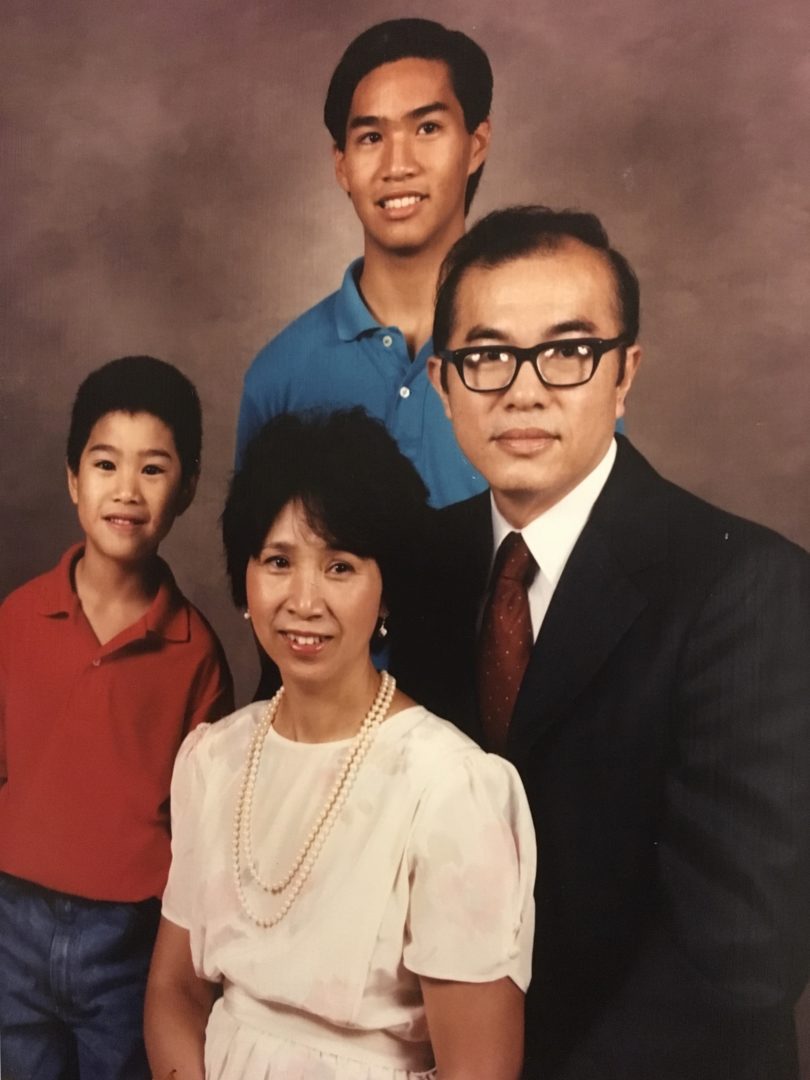
Hsu’s family![]()
Source from Mrs. Emily Hsu 07/2018
Posted in 08/2018

